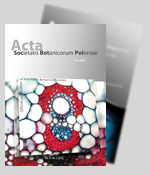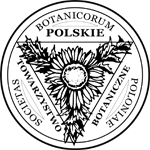The influence of Calamagrostis epigejos expansion on the species composition and soil properties of mountain mesic meadows
Abstract
Keywords
Full Text:
PDFReferences
Merunková K, Preislerová Z, Chytrý M. White Carpathian grasslands: can local ecological factors explain their extraordinary species richness? Preslia. 2012;84:311–325.
Michalcová D, Chytrý M, Pechanec V, Hájek O, Jongepier JW, Danihelka J, et al. High plant diversity of grasslands in a landscape context: a comparison of contrasting regions in Central Europe. Folia Geobot. 2014;49:117–135. https://doi.org/10.1007/s12224-013-9173-1
Roleček J, Čornej II, Tokarjuk AI. Understanding the extreme species richness of semi-dry grasslands in east-central Europe: a comparative approach. Preslia. 2014;86:13–34.
Ellenberg H. Vegetation Mitteleuropas mit den Alpen. 5. Auflage. Stuttgart: Ulmer; 1996.
Poschlod P, Bakker JP, Kahmen S. Changing land use and its impact on biodiversity. Basic Appl Ecol. 2005;6:93–98. https://doi.org/10.1016/j.baae.2004.12.001
Hejcman M, Klaudisova M, Schellberg J, Honsova D. The Rengen Grassland Experiment: plant species composition after 64 years of fertilizer application. Agric Ecosyst Environ. 2007;122:259–266. https://doi.org/10.1016/j.agee.2006.12.036
Poptcheva K, Schwartze P, Vogel A, Till K, Hölzel N. Changes in wet meadow vegetation after 20 years of different management in a field experiment (north-west Germany). Agriculture, Ecosystems and Environment. 2009;134:108–114. https://doi.org/10.1016/j.agee.2009.06.004
Waesch G, Becker T. Plant diversity differs between young and old mesic meadows in a Central European low mountain region. Agriculture, Ecosystems and Environment. 2009;129:457–464. https://doi.org/10.1016/j.agee.2008.10.022
Pruchniewicz D, Żołnierz L. The influence of environmental factors and management methods on the vegetation of mesic grasslands in a Central European mountain range. Flora. 2014;209(12):687–692. https://doi.org/10.1016/j.flora.2014.09.001
Prach K. Degradation and restoration of wet and moist meadows in the Czech Republic general trends and case studies. Acta Bot Gallica. 1997;143(4/5):441–449.
Krahulec F, Skálová H, Herben T, Hadincová V, Wildová R, Pechácková S. Vegetation changes following sheep grazing in abandoned mountain meadows. Applied Vegetation Science. 2001;4:97–102. https://doi.org/10.1111/j.1654-109X.2001.tb00239.x
Pruchniewicz D, Donath TW, Otte A, Żołnierz L, Eckstein RL. Effect of expansive species on seed rain and soil seed bank of mountain mesic meadows. Tuexenia. 2016;36:81–96.
Rebele F, Lehmann C. Biological flora of Central Europe: Calamagrostis epigejos (L.) Roth. Flora. 2001;196:325–344.
Stránská M. Successional dynamics of Cynosurus pasture after abandonment in Podkrkonoší. Plant Soil Environ. 2004;40,8:364–370.
Holub P. The expansion of Calamagrostis epigejos into alluvial meadows: comparison of aboveground biomass in relation to water regimes. Ekológia (Bratislava). 2002;21:27–37.
Somodi I, Virágh K, Podani J. The effect of the expansion of the clonal grass Calamagrostis epigejos on the species turnover of a semi-arid grassland. Applied Vegetation Science. 2008;11:187–192. https://doi.org/10.3170/2008-7-18354
Holub P, Tůma I, Záhor J, Fiala K. Different nutrient use strategies of expansive grasses Calamagrostis epigejos and Arrhenatherum elatius. Biologia. 2012;67:673–680. https://doi.org/10.2478/s11756-012-0050-9
Aiken SG, Lefkovitch LP, Armstrong KC. Calamagrostis epigejos (Poaceae) in North America, especially Ontario. Can J Bot. 1989;67:3205−3218. https://doi.org/10.1139/b89-400
Gloser V, Košvancová M, Gloser J. Changes in growth parameters and content of N-storage compounds in roots and rhizomes of Calamagrostis epigejos after repeated defoliation. Biologia, Bratislava. 2009;59(13 suppl):179–184.
Gloser V, Gloser J. Production processes in a grass Calamagrostis epigejos grown at different soil nitrogen supply. In: Gaborcik, editor. Grassland Ecology V. Proceedings of the 5th Ecological Conference. Banská Bystrica: Grassland and Mountain Agriculture Research Institute; 1999. p. 69–76.
Rebele F. Competition and coexistence of rhizomatous perennial plants along a nutrient gradient. Plant Ecol. 2002;147:77–94. https://doi.org/10.1023/A:1009808810378
Sedláková I, Fiala K. Ecological degradation of alluvial meadows due to expanding Calamagrostis epigejos. Ekológia (Bratislava). 2001;3:226–333.
Gloser V. Seasonal changes of nitrogen storage compounds in a rhizomatous grass Calamagrostis epigejos. Biol Plant. 2002;45:563–568. https://doi.org/10.1023/A:1022329210127
Kavanová M, Gloser V. The use of internal nitrogen stores in the rhizomatous grass Calamagrostis epigejos during regrowth after defoliation. Ann Bot. 2005;95:457–463. https://doi.org/10.1093/aob/mci054
Prach K, Pyšek P. Using spontaneous succession for restoration of human-disturbed habitats: experience from Central Europe. Ecol Eng. 2001;17:55–62. https://doi.org/10.1016/S0925-8574(00)00132-4
Süß K, Storm C, Zehm A, Schwabe A. Succession in inland sand ecosystems: which factors determine the occurrence of the tall grass species Calamagrostis epigejos (L.) Roth and Stipa capillata L. Plant Biol (Stuttg). 2004;6:465–476. https://doi.org/10.1055/s-2004-820871
Gloser V, Gloser J. Acclimation capability of Calamagrostis epigejos and C. arundinacea to changes in radiation environment. Photosynthetica. 1996;32(2):203–212.
Gloser V, Košvancová M, Gloser J. Regrowth dynamics of Calamagrostis epigejos after defoliation as affected by nitrogen availability. Biol Plant. 2007;51(3):501–506. https://doi.org/10.1007/s10535-007-0105-x
Allen SE. Chemical analysis of ecological materials. 2nd ed. Oxford: Blackwell Scientific Publications; 1989.
Radojević M, Bashkin VN. Practical environmental analysis. Cambridge: Royal Society of Chemistry; 2006.
StatSoft Inc. STATISTICA (data analysis software system), version 12 [Internet]. 2014 [cited 2016 Oct 13]. Available from: http://www.statsoft.com
ter Braak CJF, Šmilauer P. Canoco reference manual and user’s guide: software for ordination, version 5.0. Ithaca, NY: Microcomputer Power; 2012.
Kovach WL. MVSP – A MultiVariate Statistical Package for Windows, ver. 3.131. Pentraeth: Kovach Computing Services; 2007.
Matuszkiewicz, W. Przewodnik do oznaczania zbiorowisk roślinnych Polski. Warszawa: Wydawnictwo Naukowe PWN; 2012.
Hájková P, Hájek M, Blažková D, Kučera T, Chytrý M, Řezníčková M, et al. Louky a mezofilní pastviny. In: Chytrý M, editor. Vegetace České republiky. 1. Travinná a keříčková vegetace. Praha: Academia; 2010. p. 165–278.
Pyšek P, Jarošík V, Hulme PE, Pergl J, Hejda M, Schaffner U, et al. A global assessment of invasive plant impacts on resident species, communities and ecosystems: the interaction of impact measures, invading species’ traits and environment. Glob Chang Biol. 2012;18:1725–1737. https://doi.org/10.1111/j.1365-2486.2011.02636.x
Fiala K, Holub P, Sedláková I, Tůma I, Záhora J, Tesařová M. Reasons and consequences of expansion of Calamagrostis epigejos in alluvial meadows of landscape affected by water control measures. Ekológia (Bratislava). 2003;22(2 suppl):242–252.
Somodi I, Virágh K, Aszalós R. The effect of the abandonment of grazing on the mosaic of vegetation patches in a temperate grassland area in Hungary. Ecological Complexity. 2004;1:177–189. https://doi.org/10.1016/j.ecocom.2004.03.001
Holub P, Sedláková I, Fiala K, Tůma I, Záhora J, Tesařová M. Reasons and consequences of expansion of Calamagrostis epigejos in meadows of the Dyje River floodplain. Verhandlungen der Gesellschaft für Ökologie. 2004;34:167.
Dolečková H, Osbornová J. Competition ability and plasticity of Calamagrostis epigejos. Zprávy České Botanické Společnosti. 1990;25:35–38.
Jakob S, Tischew S, Mahn EG. Zur Rolle vor Calamagrostis epigejos (L.) Roth in den Sandtrockenrasen des Braunkohlentagebaues “Goitsche” (bei Delitzsch). Verhandlungen der Gesellschaft für Ökologie. 1996;26:797–805.
Facelli JM, Pickett STA. Plant litter: its dynamics and effects on plant community structure. Botanical Review. 1991;57:1–32. https://doi.org/10.1007/BF02858763
Brünn S. Untersuchungen zum Mineralstoffhaushalt von Calamagrostis epigejos (L.) Roth in stickstoffbelasteten Kiefernwäldern. Göttingen: Forschungszentrum Waldökosysteme; 1999. (Berichte des Forschungszentrums Waldökosysteme, Reihe A; vol 160).
Rebele F. Konkurrenz und Koexistenz bei ausdauernden Ruderalpflanzen [PhD thesis]. Hamburg: Verlag Dr. Kovac; 1996.
Lammerts EJ, Pegtel DM, Grootjans AP, van der Veen A. Nutrient limitation and vegetation changes in a coastal dune slack. J Veg Sci. 1999;10:111–122. https://doi.org/10.2307/3237166
DOI: https://doi.org/10.5586/asbp.3516
|
|
|








